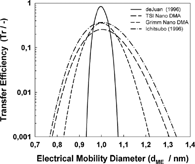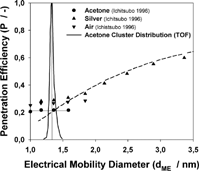A recent paper by the authors (CitationHeim et al. 2005) examined the filtration efficiency of nanoparticles in the 2.5–20 nm size range, in an attempt to determine if thermal bounce occurs. The work included a critical review of previous work, including the work of CitationIchitsubo et al. (1996), which was the only paper found by the authors which appeared to detect actual “thermal rebound.” Further investigation of the results and methods used by CitationIchitsubo et al. (1996), have allowed us to conclude with a high degree of certainty, that the results shown can be attributed to the poor sizing performance of the DMA used rather than actual particle thermal bounce effects.
For the smallest particle sizes studied, the work of CitationIchitsubo et al. (1996) utilised acetone ion clusters, which were classified using a DMA into four different size classes from 1.0 nm to 1.6 nm. These particles were then utilised for wire screen penetration measurements.
shows the classification performance of 4 different DMA types, calculated according to Stolzenburg's diffusion broadened transfer function theory (CitationStolzenburg 1988) for the 1 nm particle size range and the manufacturers maximum recommended flow rates (which will minimize diffusional broadening). In the case of the DMA used by CitationIchitsubo et al. (1996), the flow rates mentioned in the publication were used. The effect of diffusional broadening on the DMA classification performance at this size range can clearly be observed, and the DMA used by CitationIchitsubo et al (1996) shows the greatest broadening.
FIG. 1 Diffusion broadened transfer function of different DMAs for 1 nm particles calculated after Stolzenburg's transfer function theory (CitationStolzenburg 1988). The real transfer function is even broader due to non-edeal flow and geometry effects. The flow rates are given in l/min (aerosol flow/sheath flow): deJuan DMA (de CitationJuan and de la Mora 1998): 80/800; Ichitsubo DMA: 6/40; TSI Nano and Grimm Nano DMA: 2/20.

shows the extremely narrow—near monodisperse—distribution which is obtained when acetone ion clusters are measured by a Time of Flight spectrometer (TOF, from (CitationMäkela et al. 1996)), in comparison to the broad distribution for acetone clusters shown in CitationIchitsubo et al. (1996) measured with their DMA. It is clear from that the inaccuracy of the DMA in this region (due to diffusional broadening), can allow a monodisperse distribution to be classified into what appears to be a number of “different” sizes, which are, in actuality all nearly identical. It should be noted, that the same method was used by both authors to produce the acetone clusters.
FIG. 2 Acetone cluster size distribution measured with a DMA (CitationIchitsubo et al. 1996) and with a Time-of-Flight (TOF) Spectrometer (CitationMäkela et al. 1996).

thus shows the size distribution of the acetone ions (CitationMäkela et al. 1996), together with the mesh penetration results of CitationIchitsubo et al. (1996). It can clearly be observed that the acetone ion cluster size is close to the middle of the data shown by CitationIchitsubo et al. (1996) where the mesh penetration deviates from the theory and becomes almost constant—which is the reported “onset of thermal rebound.” It would be expected that the acetone ions, when classified by a DMA into these four “different” (however actually identical) sizes, that the penetration through the mesh would remain the same for all four such particle sizes, as was observed. It should be mentioned, that the mean acetone cluster size of 1.33 nm measured by the TOF instrument shows an excellent agreement with the theory of CitationCheng and Yeh (1980) for penetration through mesh screens, and therefore proves the accuracy of this theory, even for very small particles. The deviation observed for the silver particles and the “clean air” can also be attributed to very narrowly distributed ion clusters formed in the Am241 neutralizer used by the authors, which appear to be approximately 1.5 to 1.6 nm in size.
FIG. 3 Result of CitationIchitsubo et al. (1996) which were reported as thermal rebound shown with acetone ion cluster distribution reported by CitationMäkela et al. (1996).

Additional comment should be made on a later paper by many of the same authors (CitationAlonso et al. 1997), which showed one point below 2 nm measured by a different method, which also corresponded to the theory. CitationAlonso et al. (1997) stated that the work of CitationIchitsubo et al. (1996) reached erroneous conclusions due to inaccurate particle size measurement of particles below 2–3 nm, which is in agreement with this comment.
It can therefore be concluded that the “thermal rebound” reported by CitationIchitsubo et al. (1996) was, in actuality, an artefact of DMA diffusional broadening, and since this is the only paper we have found which appeared to show experimental evidence of thermal rebound, we can now therefore conclude that this effect does not occur down to sizes as low as 1.33 nm. Therefore the question must be asked if thermal rebound is relevant to filtration processes if it only occurs at some particle size below 1.33 nm.
REFERENCES
- Alonso , M. , Kousaka , Y. , Hashimoto , T. and Hashimoto , N. 1997 . Penetration of Nanometer-Sized Aerosol Particles Through Wire Screen and Laminar Flow Tube . Aerosol Sci. Technol. , 27 : 471 – 480 . [CSA]
- Cheng , Y. S. and Yeh , H. C. 1980 . Theory of a Screen-Type Diffusion Battery . J. Aerosol Sci. , 11 : 313 – 320 . [CSA] [CROSSREF]
- de Juan , L. and de la Mora , J. F. 1998 . High Resolution Size Analysis of Nanoparticles and ions: Running a Vienna DMA of Near Optimal Length at Reynolds Numbers Up to 5000 . J. Aerosol Sci. , 29 : 617 – 626 . [CSA] [CROSSREF]
- Heim , M. , Mullins , B. J. , Wild , M. , Meyer , J. and Kasper , G. 2005 . Filtration Efficiency of Aerosol Particles Below 20 Nanometers . Aerosol Sci. Technol. , 39 : 782 – 789 . [CSA]
- Ichitsubo , H. , Hashimoto , T. , Alonso , M. and Kousaka , Y. 1996 . Penetration of Ultrafine Particles and Ion Clusters Through Wire Screens . Aerosol Sci. Technol. , 24 : 119 – 127 . [CSA]
- Mäkela , J. M. , Jokinen , V. , Mattila , T. , Ukkonen , A. and Keskinen , J. 1996 . Mobility Distribution of Acetone Cluster Ions . J. Aerosol Sci. , 27 : 175 – 190 . [CSA] [CROSSREF]
- Stolzenburg , M. R. 1988 . An Ultrafine Aerosol Size Distribution Measuring System. Minneapolis , University of Minnesota .